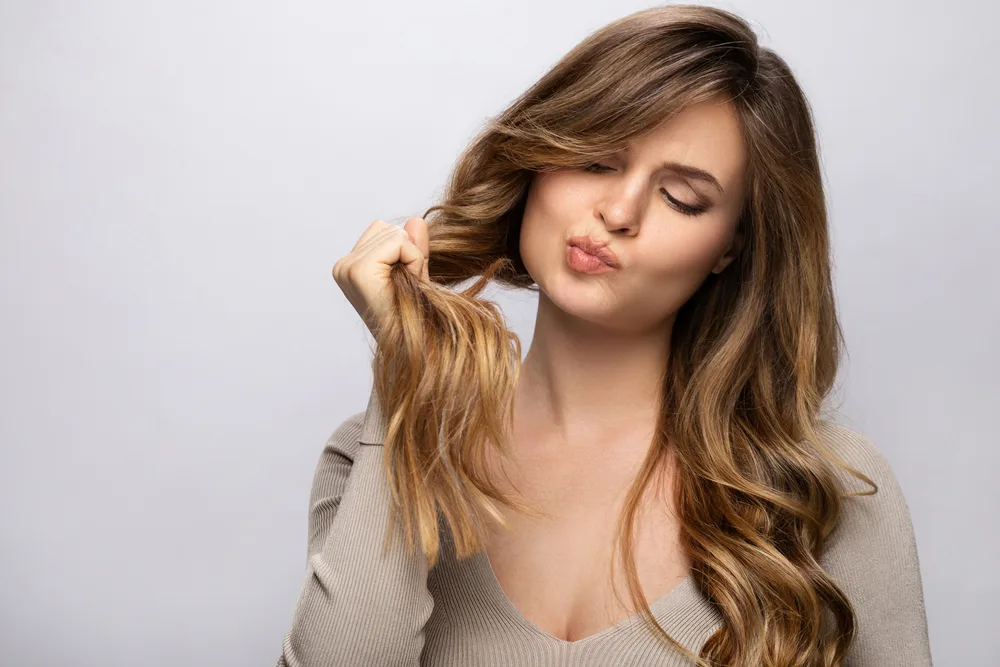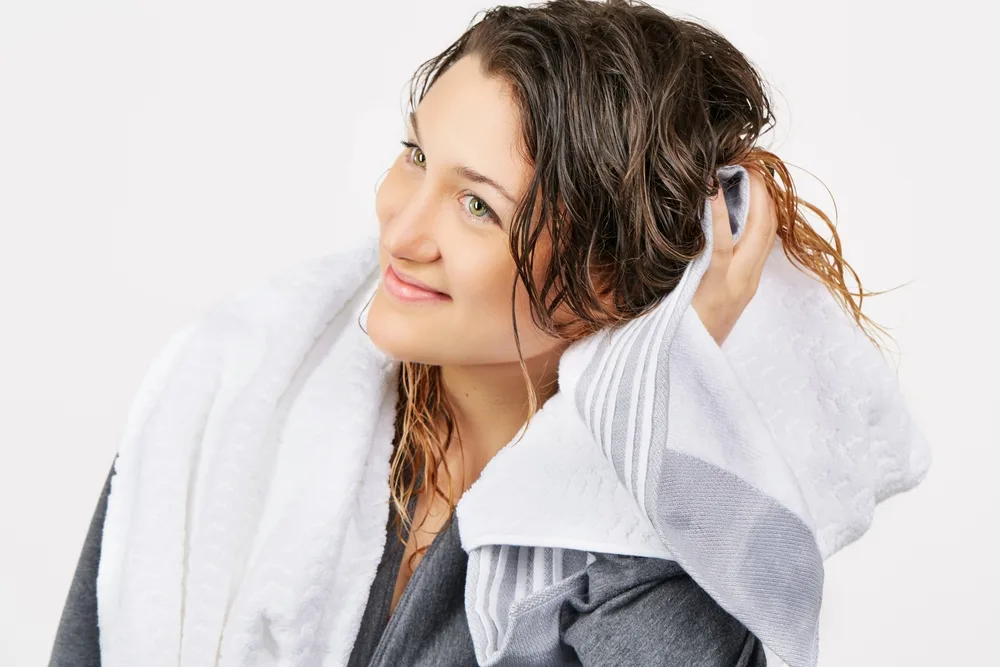Jump to:
Styling your hair can become a nightmare if your straight hair is actually wavy. Read on to learn more about the signs of wavy hair and how to take care of your gorgeous tousled tresses.
What Is Wavy Hair?
Wavy hair is the classic in-between hair texture: not quite straight, not quite curly. Although wavy hair is often mistaken for frizzy straight hair, waves are a loose curl pattern that requires significantly different care than straight hair.
You get your hair texture from the shape of your hair follicles, the tiny holes out of which your hair grows. A perfectly round hair follicle creates pin-straight hair, whereas an oval-shaped hair follicle creates curly hair.
Wavy hair comes from follicles with a shape somewhere between a circle and an oval. Genetics determine your hair follicle shape. However, hormonal changes can activate different genetic traits, changing your follicle shape and, thus, your hair texture.
Understanding your hair texture and follicle shape is essential to care properly for your hair. Poorly maintained wavy hair can result in many problems, including:
- Breakage
- Frizz
- Tangles
- Dryness
Fortunately, there are some simple signs you can look for if you suspect your hair has more texture than you first thought.
How to Know Your Straight Hair Is Actually Wavy

Blackday/Shutterstock
Wavy hair can be challenging to identify. Those s-shaped curls behave quite differently under various conditions, creating the illusion of poofy but straight hair.
Furthermore, no person’s curl pattern is exactly alike, so referencing the wavy hair of your friends or celebrities may leave you feeling even more lost. You can look for a few common wavy hair traits when determining your hair texture.
1. Your Hair Curls When Wet
The easiest time to observe your hair texture is when it is wet. Your hair’s chemical structure makes it sensitive to hydrogen. When your hair interacts with water (hydrogen and oxygen), it forms hydrogen bonds between the hair’s protein strands.
These bonds cause the hair proteins to fold back on each other, creating a curlier texture. Now, everyone’s hair curls at least a little when it is wet. However, if your wet hair is especially prone to curling, it’s a big clue that your straight hair is actually wavy.
Next time you get out of the shower, wait a few minutes before you begin styling your wet hair. Then, observe your hair in the mirror and see what texture naturally forms when left untouched.
2. You Have Poofy Hair
Do you spend hours trying to get that sleek, straight hair look only for your hair to poof out into a pear shape? If so, your hair texture probably deserves a little more love and attention.
Waves and curls suffer when you brush them out dry. Aggressive brushing will break the delicate structure of curly hair, leading to that weird poofy texture.
When you try to force wavy hair into a flat, smooth texture, all you will get is extremely stretched-out and broken waves. On the other hand, embracing your hair’s natural volume will leave your wave pattern intact and give you an attractive, tousled look.
Read Next: How to Get Fluffy Hair
3. Your Hair Is Tangled and Uncooperative
Neglected wavy or curly hair will get tangled quickly and often. Since your natural hair pattern is an s-shape, your hair strands are more prone to interlocking and forming knots. Trying to detangle dry hair with a brush, as you would with straight hair, will only create poofy, stretched-out curls.
Since wavy hair is more delicate than straight hair, your hair strands may break when you attempt to detangle your hair dry. For this reason, many people with textured hair prefer to detangle their hair when wet with a moisturizing conditioner.
Read Next: How to Detangle Matted Hair
4. You Have Frizzy Hair
Frizzy hair is a telltale sign of secretly wavy hair. Despite how some people talk about it, frizzy is not a hair texture. Frizz is a symptom of dehydrated textured hair. Your hair becomes frizzy when it is attracted to moisture in the air, such as when it is humid outside.
Naturally curly or wavy hair is vulnerable to frizz because this hair type tends to need more moisture to stay hydrated. If your straight hair is actually wavy, it is likely in serious need of extra moisture.
Therefore, your thirsty hair is constantly reaching out into the air to get more water from the atmosphere. To put an end to the non-stop frizz, you will need to invest in hydrating hair products designed for waves and curls.
Read Next: How to Get Rid of Frizzy Hair
How to Check If Your Hair Is Wavy

Image Source Trading Ltd/Shutterstock
Now that you’re familiar with all the symptoms of secretly wavy hair, you may be ready to make a diagnosis. However, you might want to confirm your suspicions before you buy an entirely new set of hair products. You can try out a few exercises to check whether or not you have a wave pattern in your hair.
Scrunch Wet Hair
Scrunching is a popular styling method for wavy and curly hair. Scrunching involves cupping your wet, detangled hair in your hands, pushing upwards, and squeezing.
Many people prefer to do this with their heads tilted to the side or upside down. For the scrunch test, don’t touch your hair after you’ve squeezed out the excess water. The point of this test is to see how much your hair retains a curly pattern as it dries.
If your dry hair loses most of the curl, your hair is only slightly wavy. If your dry hair has a distinctive s or c-shaped texture, you have either tight waves or loose curls.
Read Next: How to Plop Your Curly Hair
Use Hair Gel
You can also intensify the scrunching test by incorporating hair gel. A strong hold gel or mousse will protect your hair as it dries and may make it easier for you to identify your hair’s wave or curl pattern.
After scrunching out water from your wet hair, apply some gel or mousse to your hair, and scrunch again. For this test, there’s no need to go out and purchase a special hair product — wait until you feel confident about your hair texture before buying anything new.
Once your hair is dry, you may notice your hair has a crunchy feeling from the gel. Scrunching your hair again when it is dry will get rid of that feeling — this is commonly known in the curly hair community as scrunching out the crunch.
After your hair is crunch-free, consider your hair texture: if the gel has helped to shape some beautiful waves and curls, your wavy hair is confirmed.
Read Next: Determine Your Hair Type With Our Short Quiz!
How to Take Care of Wavy Hair

Alliance Images/Shutterstock
Taking care of wavy hair doesn’t have to be complicated, but it does require different strategies and habits than you’re used to with straight hair.
Avoid Heat
Curly and wavy hair is delicate, so save the heat styling tools for special occasions. Heat damage will weaken your curl pattern and cause an aggravating amount of frizz. When using a heat styling tool, use a good heat protectant first and follow up the next day with a restorative hair mask.
Moisture and Protein
Moisture and protein is the key to good waves and curls. Your wavy hair thrives on moisture and will produce juicy, defined waves when properly hydrated. So nourishing your hair with protein-heavy products will keep your waves strong and promote curl definition.
Read Next: How to Straighten Hair Without Heat
Frequently Asked Questions
Here are the answers to some of the most frequently asked questions about straight hair that is actually wavy.
Why is my straight hair now wavy?
A hormonal change usually causes a change in hair texture. Things such as puberty, menopause, and other hormone-related conditions can trigger a change in your hair follicle’s shape.
Why is my hair wavy underneath but straight on top?
If your hair is wavy underneath but straight on top, you probably have wavy hair but need a different haircut. A hairstylist can trim the heavier top layer shorter so that the waves are less weighed down, creating better volume and texture.
Does hair get curlier as it gets longer?
Your hair’s curl pattern will get looser as it gets longer. This is because the more weight pulling down on your hair, the more your curls get stretched out. For greater curl definition, consider cutting your hair a little shorter.
What does type 2A hair look like?
Type 2A hair is hair with a highly loose wave texture. In the standard hair texture categorization system, it is the loosest curl pattern you can have without having straight hair.
How often should you wash wavy hair?
The frequency with which you wash your wavy hair depends on your scalp health and the tightness of your wave pattern. Generally, you should wash wavy hair three or four times a week.
So, Does It Matter If My Straight Hair Is Actually Wavy?
Understanding your hair texture will significantly impact how you care for your hair. By recognizing that your straight hair is actually wavy, you can go from having frizzy, poofy straight hair to having stylish and romantic waves. Happy styling!
